Nursing Assignment: Cancer in Canada, Disparities and Interventions
VerifiedAdded on 2022/10/02
|10
|2519
|434
Report
AI Summary
This nursing assignment provides a comprehensive analysis of cancer in Canada, examining its prevalence, disparities, and the impact of social determinants of health. The report delves into the role of primary health care nurses in addressing cancer-related issues, including interventions, cultural competence, and patient-centered care. It explores epidemiological studies, identifies factors contributing to healthcare inequities, and discusses how nursing practices can improve patient outcomes. The assignment also emphasizes the importance of cultural competence in healthcare delivery, highlighting its benefits for both patients and healthcare providers, and references recent literature to support its findings. It further provides statistics on cancer diagnosis and mortality rates in Canada, and the impact of nursing interventions to improve patient outcomes. The report emphasizes the need for increased nursing practitioners, patient-centered care, and the establishment of multidisciplinary teams.
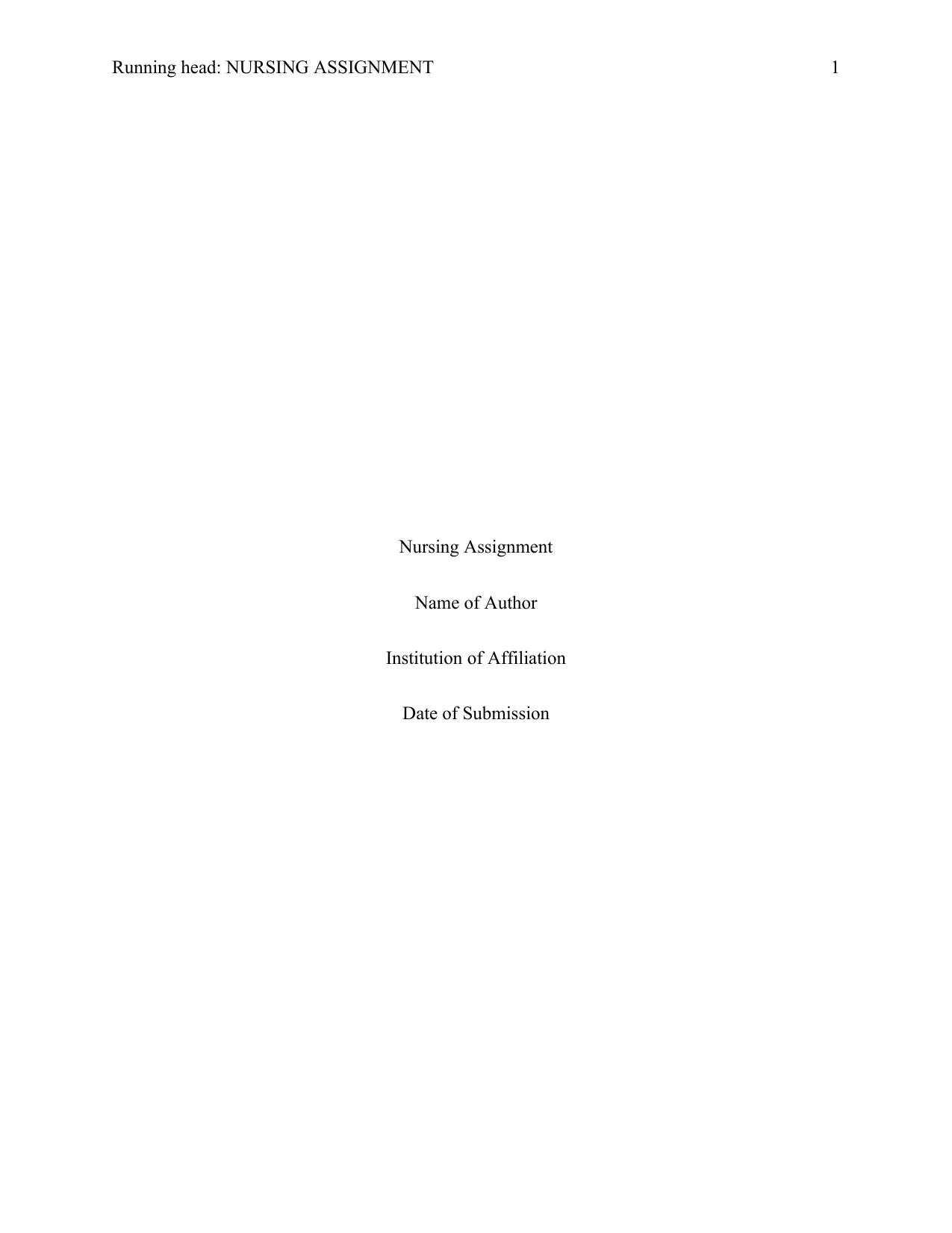
Running head: NURSING ASSIGNMENT 1
Nursing Assignment
Name of Author
Institution of Affiliation
Date of Submission
Nursing Assignment
Name of Author
Institution of Affiliation
Date of Submission
Paraphrase This Document
Need a fresh take? Get an instant paraphrase of this document with our AI Paraphraser
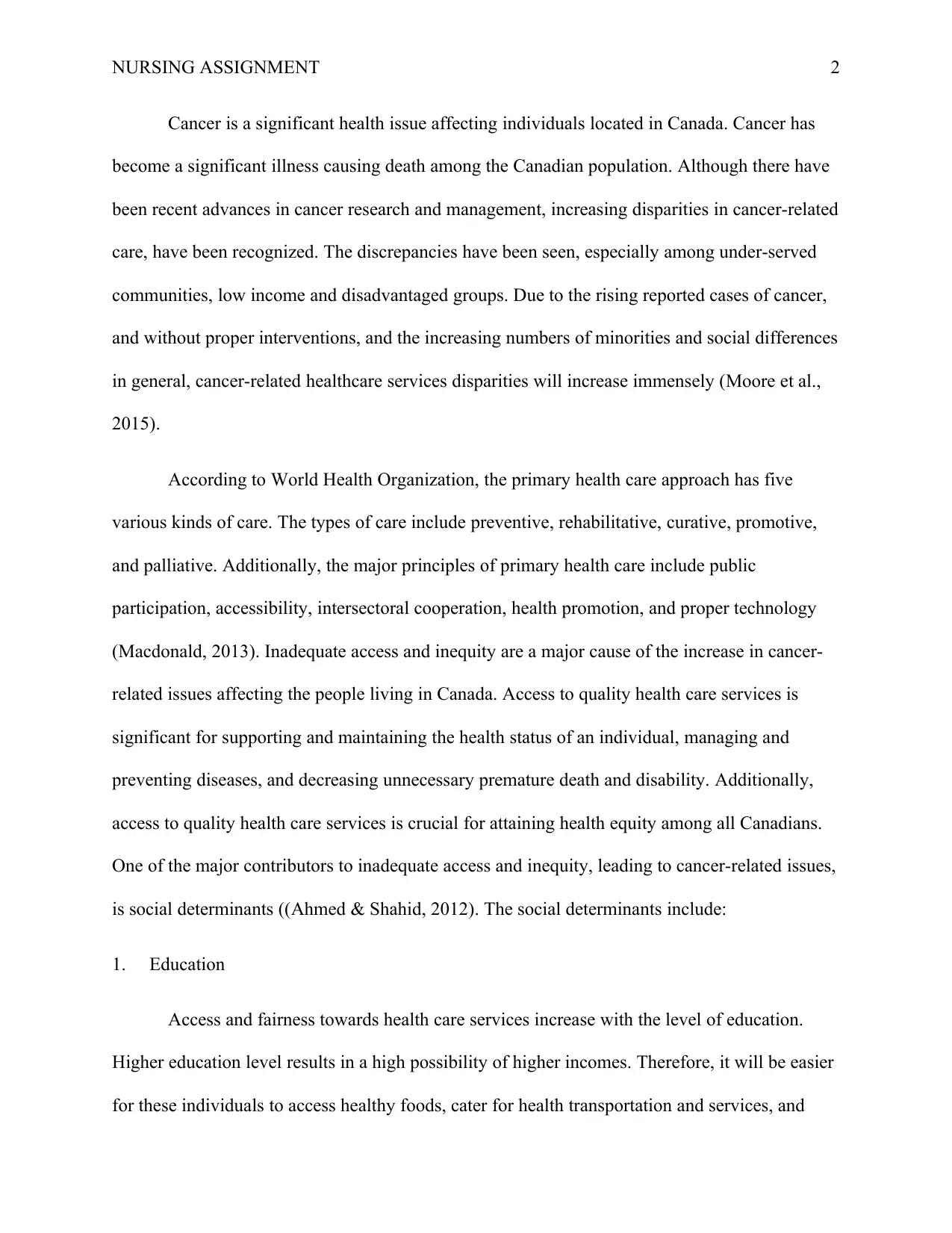
NURSING ASSIGNMENT 2
Cancer is a significant health issue affecting individuals located in Canada. Cancer has
become a significant illness causing death among the Canadian population. Although there have
been recent advances in cancer research and management, increasing disparities in cancer-related
care, have been recognized. The discrepancies have been seen, especially among under-served
communities, low income and disadvantaged groups. Due to the rising reported cases of cancer,
and without proper interventions, and the increasing numbers of minorities and social differences
in general, cancer-related healthcare services disparities will increase immensely (Moore et al.,
2015).
According to World Health Organization, the primary health care approach has five
various kinds of care. The types of care include preventive, rehabilitative, curative, promotive,
and palliative. Additionally, the major principles of primary health care include public
participation, accessibility, intersectoral cooperation, health promotion, and proper technology
(Macdonald, 2013). Inadequate access and inequity are a major cause of the increase in cancer-
related issues affecting the people living in Canada. Access to quality health care services is
significant for supporting and maintaining the health status of an individual, managing and
preventing diseases, and decreasing unnecessary premature death and disability. Additionally,
access to quality health care services is crucial for attaining health equity among all Canadians.
One of the major contributors to inadequate access and inequity, leading to cancer-related issues,
is social determinants ((Ahmed & Shahid, 2012). The social determinants include:
1. Education
Access and fairness towards health care services increase with the level of education.
Higher education level results in a high possibility of higher incomes. Therefore, it will be easier
for these individuals to access healthy foods, cater for health transportation and services, and
Cancer is a significant health issue affecting individuals located in Canada. Cancer has
become a significant illness causing death among the Canadian population. Although there have
been recent advances in cancer research and management, increasing disparities in cancer-related
care, have been recognized. The discrepancies have been seen, especially among under-served
communities, low income and disadvantaged groups. Due to the rising reported cases of cancer,
and without proper interventions, and the increasing numbers of minorities and social differences
in general, cancer-related healthcare services disparities will increase immensely (Moore et al.,
2015).
According to World Health Organization, the primary health care approach has five
various kinds of care. The types of care include preventive, rehabilitative, curative, promotive,
and palliative. Additionally, the major principles of primary health care include public
participation, accessibility, intersectoral cooperation, health promotion, and proper technology
(Macdonald, 2013). Inadequate access and inequity are a major cause of the increase in cancer-
related issues affecting the people living in Canada. Access to quality health care services is
significant for supporting and maintaining the health status of an individual, managing and
preventing diseases, and decreasing unnecessary premature death and disability. Additionally,
access to quality health care services is crucial for attaining health equity among all Canadians.
One of the major contributors to inadequate access and inequity, leading to cancer-related issues,
is social determinants ((Ahmed & Shahid, 2012). The social determinants include:
1. Education
Access and fairness towards health care services increase with the level of education.
Higher education level results in a high possibility of higher incomes. Therefore, it will be easier
for these individuals to access healthy foods, cater for health transportation and services, and
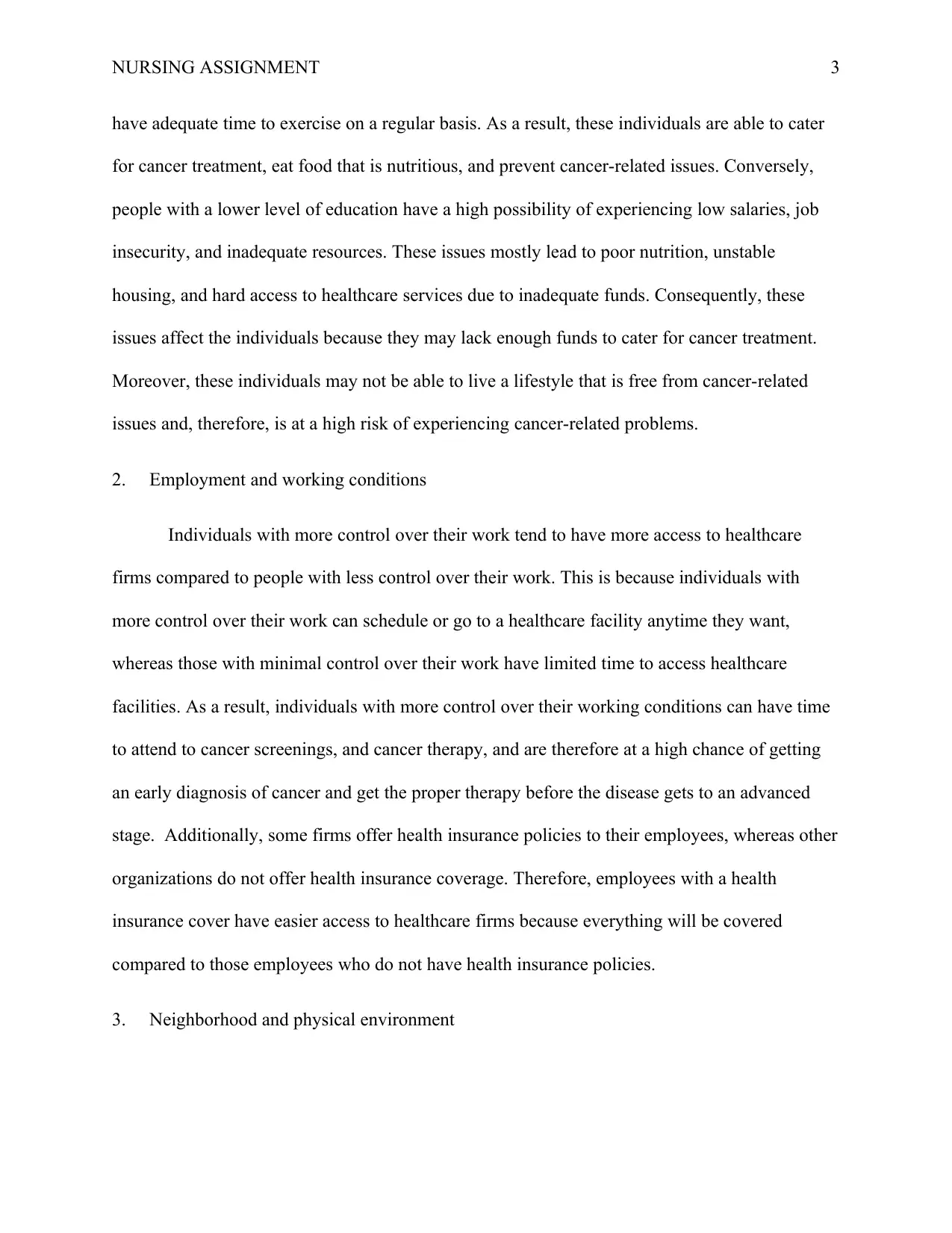
NURSING ASSIGNMENT 3
have adequate time to exercise on a regular basis. As a result, these individuals are able to cater
for cancer treatment, eat food that is nutritious, and prevent cancer-related issues. Conversely,
people with a lower level of education have a high possibility of experiencing low salaries, job
insecurity, and inadequate resources. These issues mostly lead to poor nutrition, unstable
housing, and hard access to healthcare services due to inadequate funds. Consequently, these
issues affect the individuals because they may lack enough funds to cater for cancer treatment.
Moreover, these individuals may not be able to live a lifestyle that is free from cancer-related
issues and, therefore, is at a high risk of experiencing cancer-related problems.
2. Employment and working conditions
Individuals with more control over their work tend to have more access to healthcare
firms compared to people with less control over their work. This is because individuals with
more control over their work can schedule or go to a healthcare facility anytime they want,
whereas those with minimal control over their work have limited time to access healthcare
facilities. As a result, individuals with more control over their working conditions can have time
to attend to cancer screenings, and cancer therapy, and are therefore at a high chance of getting
an early diagnosis of cancer and get the proper therapy before the disease gets to an advanced
stage. Additionally, some firms offer health insurance policies to their employees, whereas other
organizations do not offer health insurance coverage. Therefore, employees with a health
insurance cover have easier access to healthcare firms because everything will be covered
compared to those employees who do not have health insurance policies.
3. Neighborhood and physical environment
have adequate time to exercise on a regular basis. As a result, these individuals are able to cater
for cancer treatment, eat food that is nutritious, and prevent cancer-related issues. Conversely,
people with a lower level of education have a high possibility of experiencing low salaries, job
insecurity, and inadequate resources. These issues mostly lead to poor nutrition, unstable
housing, and hard access to healthcare services due to inadequate funds. Consequently, these
issues affect the individuals because they may lack enough funds to cater for cancer treatment.
Moreover, these individuals may not be able to live a lifestyle that is free from cancer-related
issues and, therefore, is at a high risk of experiencing cancer-related problems.
2. Employment and working conditions
Individuals with more control over their work tend to have more access to healthcare
firms compared to people with less control over their work. This is because individuals with
more control over their work can schedule or go to a healthcare facility anytime they want,
whereas those with minimal control over their work have limited time to access healthcare
facilities. As a result, individuals with more control over their working conditions can have time
to attend to cancer screenings, and cancer therapy, and are therefore at a high chance of getting
an early diagnosis of cancer and get the proper therapy before the disease gets to an advanced
stage. Additionally, some firms offer health insurance policies to their employees, whereas other
organizations do not offer health insurance coverage. Therefore, employees with a health
insurance cover have easier access to healthcare firms because everything will be covered
compared to those employees who do not have health insurance policies.
3. Neighborhood and physical environment
⊘ This is a preview!⊘
Do you want full access?
Subscribe today to unlock all pages.

Trusted by 1+ million students worldwide
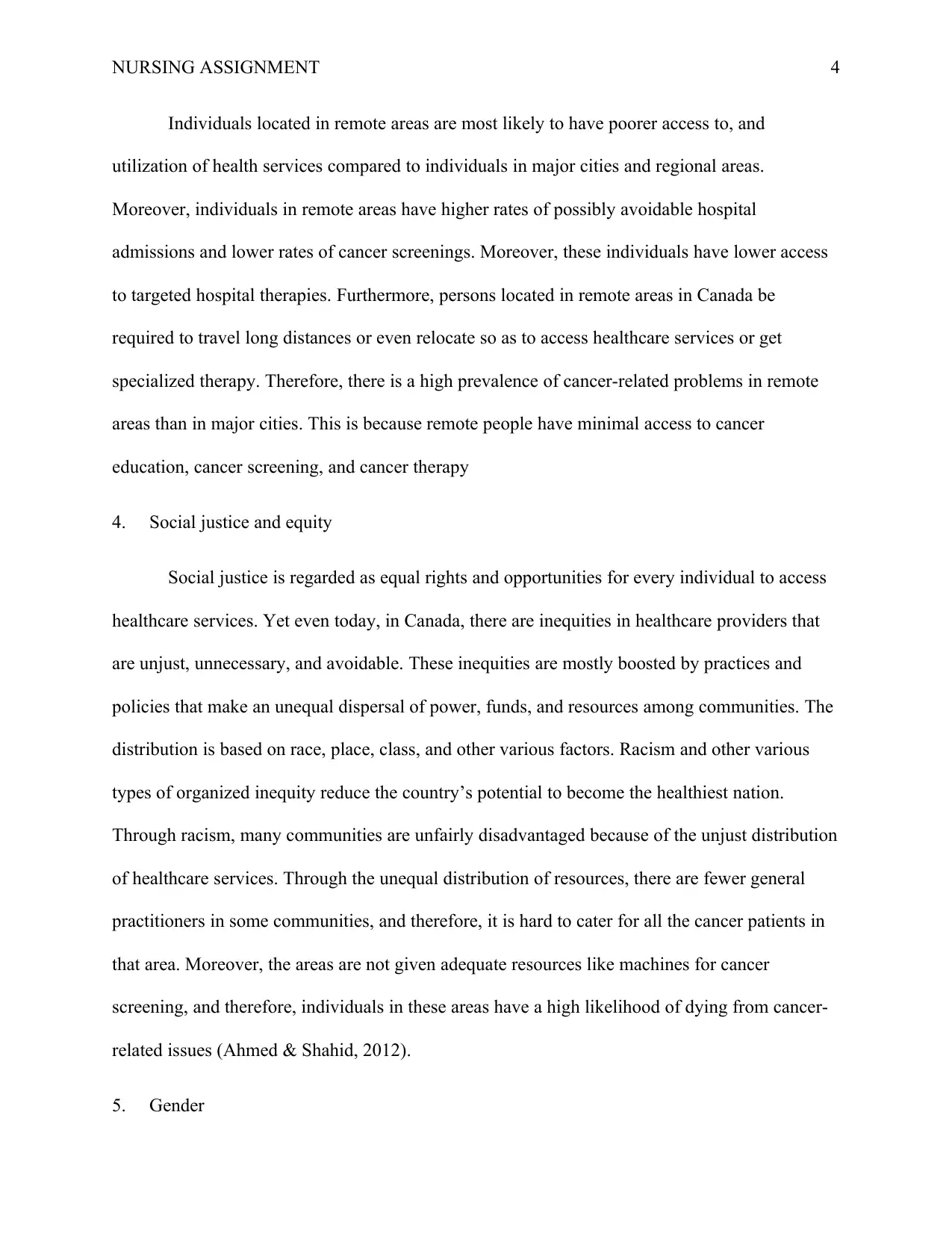
NURSING ASSIGNMENT 4
Individuals located in remote areas are most likely to have poorer access to, and
utilization of health services compared to individuals in major cities and regional areas.
Moreover, individuals in remote areas have higher rates of possibly avoidable hospital
admissions and lower rates of cancer screenings. Moreover, these individuals have lower access
to targeted hospital therapies. Furthermore, persons located in remote areas in Canada be
required to travel long distances or even relocate so as to access healthcare services or get
specialized therapy. Therefore, there is a high prevalence of cancer-related problems in remote
areas than in major cities. This is because remote people have minimal access to cancer
education, cancer screening, and cancer therapy
4. Social justice and equity
Social justice is regarded as equal rights and opportunities for every individual to access
healthcare services. Yet even today, in Canada, there are inequities in healthcare providers that
are unjust, unnecessary, and avoidable. These inequities are mostly boosted by practices and
policies that make an unequal dispersal of power, funds, and resources among communities. The
distribution is based on race, place, class, and other various factors. Racism and other various
types of organized inequity reduce the country’s potential to become the healthiest nation.
Through racism, many communities are unfairly disadvantaged because of the unjust distribution
of healthcare services. Through the unequal distribution of resources, there are fewer general
practitioners in some communities, and therefore, it is hard to cater for all the cancer patients in
that area. Moreover, the areas are not given adequate resources like machines for cancer
screening, and therefore, individuals in these areas have a high likelihood of dying from cancer-
related issues (Ahmed & Shahid, 2012).
5. Gender
Individuals located in remote areas are most likely to have poorer access to, and
utilization of health services compared to individuals in major cities and regional areas.
Moreover, individuals in remote areas have higher rates of possibly avoidable hospital
admissions and lower rates of cancer screenings. Moreover, these individuals have lower access
to targeted hospital therapies. Furthermore, persons located in remote areas in Canada be
required to travel long distances or even relocate so as to access healthcare services or get
specialized therapy. Therefore, there is a high prevalence of cancer-related problems in remote
areas than in major cities. This is because remote people have minimal access to cancer
education, cancer screening, and cancer therapy
4. Social justice and equity
Social justice is regarded as equal rights and opportunities for every individual to access
healthcare services. Yet even today, in Canada, there are inequities in healthcare providers that
are unjust, unnecessary, and avoidable. These inequities are mostly boosted by practices and
policies that make an unequal dispersal of power, funds, and resources among communities. The
distribution is based on race, place, class, and other various factors. Racism and other various
types of organized inequity reduce the country’s potential to become the healthiest nation.
Through racism, many communities are unfairly disadvantaged because of the unjust distribution
of healthcare services. Through the unequal distribution of resources, there are fewer general
practitioners in some communities, and therefore, it is hard to cater for all the cancer patients in
that area. Moreover, the areas are not given adequate resources like machines for cancer
screening, and therefore, individuals in these areas have a high likelihood of dying from cancer-
related issues (Ahmed & Shahid, 2012).
5. Gender
Paraphrase This Document
Need a fresh take? Get an instant paraphrase of this document with our AI Paraphraser
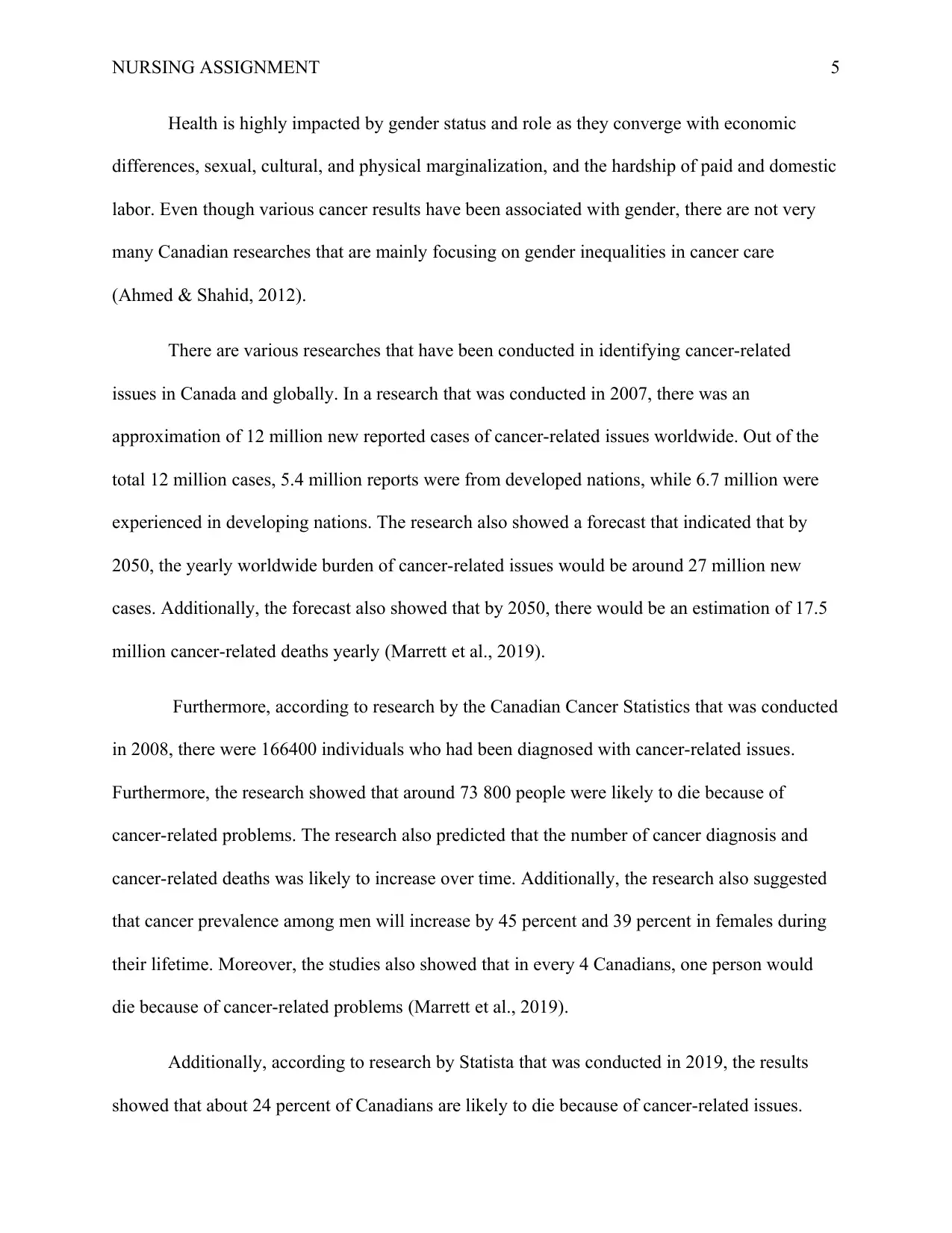
NURSING ASSIGNMENT 5
Health is highly impacted by gender status and role as they converge with economic
differences, sexual, cultural, and physical marginalization, and the hardship of paid and domestic
labor. Even though various cancer results have been associated with gender, there are not very
many Canadian researches that are mainly focusing on gender inequalities in cancer care
(Ahmed & Shahid, 2012).
There are various researches that have been conducted in identifying cancer-related
issues in Canada and globally. In a research that was conducted in 2007, there was an
approximation of 12 million new reported cases of cancer-related issues worldwide. Out of the
total 12 million cases, 5.4 million reports were from developed nations, while 6.7 million were
experienced in developing nations. The research also showed a forecast that indicated that by
2050, the yearly worldwide burden of cancer-related issues would be around 27 million new
cases. Additionally, the forecast also showed that by 2050, there would be an estimation of 17.5
million cancer-related deaths yearly (Marrett et al., 2019).
Furthermore, according to research by the Canadian Cancer Statistics that was conducted
in 2008, there were 166400 individuals who had been diagnosed with cancer-related issues.
Furthermore, the research showed that around 73 800 people were likely to die because of
cancer-related problems. The research also predicted that the number of cancer diagnosis and
cancer-related deaths was likely to increase over time. Additionally, the research also suggested
that cancer prevalence among men will increase by 45 percent and 39 percent in females during
their lifetime. Moreover, the studies also showed that in every 4 Canadians, one person would
die because of cancer-related problems (Marrett et al., 2019).
Additionally, according to research by Statista that was conducted in 2019, the results
showed that about 24 percent of Canadians are likely to die because of cancer-related issues.
Health is highly impacted by gender status and role as they converge with economic
differences, sexual, cultural, and physical marginalization, and the hardship of paid and domestic
labor. Even though various cancer results have been associated with gender, there are not very
many Canadian researches that are mainly focusing on gender inequalities in cancer care
(Ahmed & Shahid, 2012).
There are various researches that have been conducted in identifying cancer-related
issues in Canada and globally. In a research that was conducted in 2007, there was an
approximation of 12 million new reported cases of cancer-related issues worldwide. Out of the
total 12 million cases, 5.4 million reports were from developed nations, while 6.7 million were
experienced in developing nations. The research also showed a forecast that indicated that by
2050, the yearly worldwide burden of cancer-related issues would be around 27 million new
cases. Additionally, the forecast also showed that by 2050, there would be an estimation of 17.5
million cancer-related deaths yearly (Marrett et al., 2019).
Furthermore, according to research by the Canadian Cancer Statistics that was conducted
in 2008, there were 166400 individuals who had been diagnosed with cancer-related issues.
Furthermore, the research showed that around 73 800 people were likely to die because of
cancer-related problems. The research also predicted that the number of cancer diagnosis and
cancer-related deaths was likely to increase over time. Additionally, the research also suggested
that cancer prevalence among men will increase by 45 percent and 39 percent in females during
their lifetime. Moreover, the studies also showed that in every 4 Canadians, one person would
die because of cancer-related problems (Marrett et al., 2019).
Additionally, according to research by Statista that was conducted in 2019, the results
showed that about 24 percent of Canadians are likely to die because of cancer-related issues.
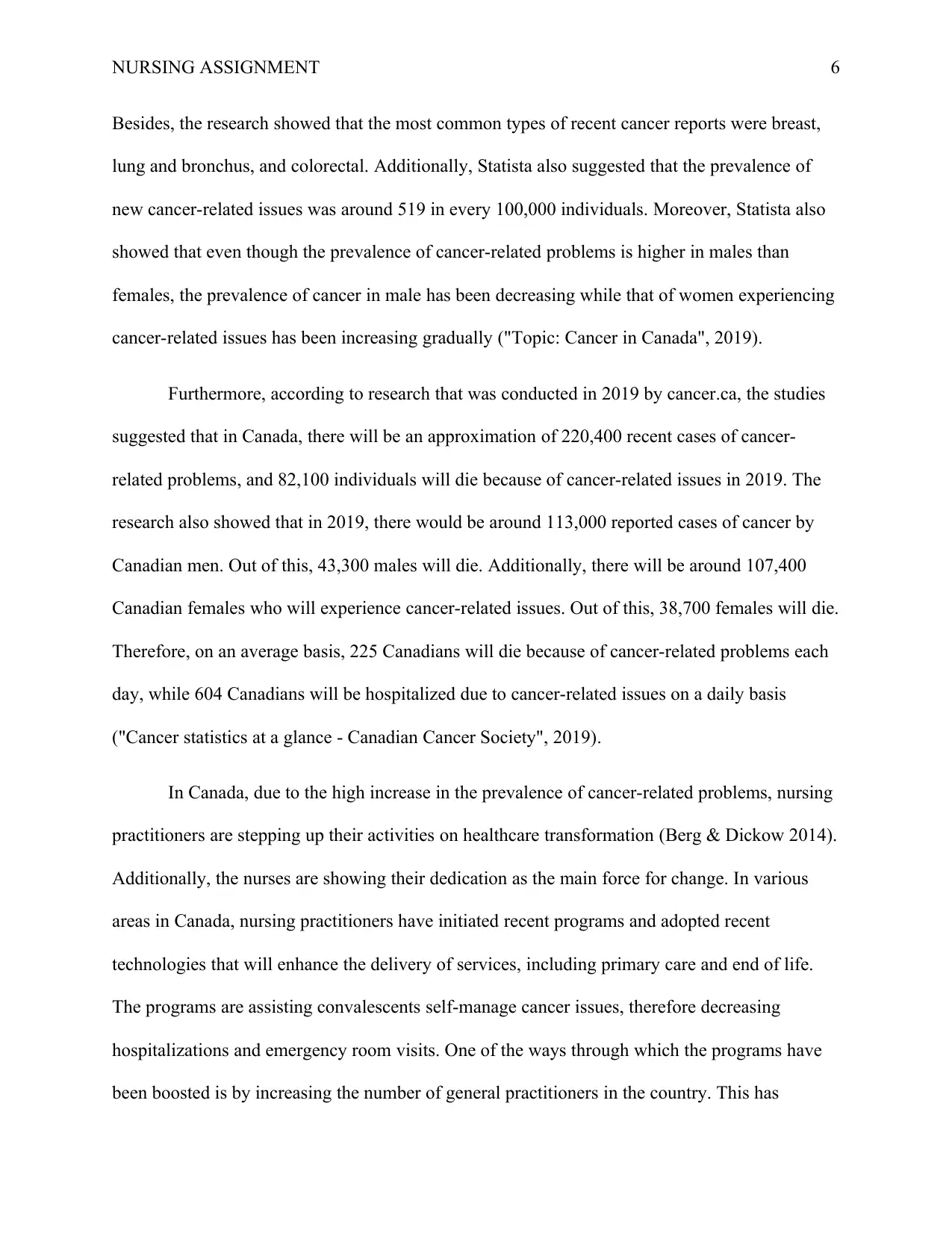
NURSING ASSIGNMENT 6
Besides, the research showed that the most common types of recent cancer reports were breast,
lung and bronchus, and colorectal. Additionally, Statista also suggested that the prevalence of
new cancer-related issues was around 519 in every 100,000 individuals. Moreover, Statista also
showed that even though the prevalence of cancer-related problems is higher in males than
females, the prevalence of cancer in male has been decreasing while that of women experiencing
cancer-related issues has been increasing gradually ("Topic: Cancer in Canada", 2019).
Furthermore, according to research that was conducted in 2019 by cancer.ca, the studies
suggested that in Canada, there will be an approximation of 220,400 recent cases of cancer-
related problems, and 82,100 individuals will die because of cancer-related issues in 2019. The
research also showed that in 2019, there would be around 113,000 reported cases of cancer by
Canadian men. Out of this, 43,300 males will die. Additionally, there will be around 107,400
Canadian females who will experience cancer-related issues. Out of this, 38,700 females will die.
Therefore, on an average basis, 225 Canadians will die because of cancer-related problems each
day, while 604 Canadians will be hospitalized due to cancer-related issues on a daily basis
("Cancer statistics at a glance - Canadian Cancer Society", 2019).
In Canada, due to the high increase in the prevalence of cancer-related problems, nursing
practitioners are stepping up their activities on healthcare transformation (Berg & Dickow 2014).
Additionally, the nurses are showing their dedication as the main force for change. In various
areas in Canada, nursing practitioners have initiated recent programs and adopted recent
technologies that will enhance the delivery of services, including primary care and end of life.
The programs are assisting convalescents self-manage cancer issues, therefore decreasing
hospitalizations and emergency room visits. One of the ways through which the programs have
been boosted is by increasing the number of general practitioners in the country. This has
Besides, the research showed that the most common types of recent cancer reports were breast,
lung and bronchus, and colorectal. Additionally, Statista also suggested that the prevalence of
new cancer-related issues was around 519 in every 100,000 individuals. Moreover, Statista also
showed that even though the prevalence of cancer-related problems is higher in males than
females, the prevalence of cancer in male has been decreasing while that of women experiencing
cancer-related issues has been increasing gradually ("Topic: Cancer in Canada", 2019).
Furthermore, according to research that was conducted in 2019 by cancer.ca, the studies
suggested that in Canada, there will be an approximation of 220,400 recent cases of cancer-
related problems, and 82,100 individuals will die because of cancer-related issues in 2019. The
research also showed that in 2019, there would be around 113,000 reported cases of cancer by
Canadian men. Out of this, 43,300 males will die. Additionally, there will be around 107,400
Canadian females who will experience cancer-related issues. Out of this, 38,700 females will die.
Therefore, on an average basis, 225 Canadians will die because of cancer-related problems each
day, while 604 Canadians will be hospitalized due to cancer-related issues on a daily basis
("Cancer statistics at a glance - Canadian Cancer Society", 2019).
In Canada, due to the high increase in the prevalence of cancer-related problems, nursing
practitioners are stepping up their activities on healthcare transformation (Berg & Dickow 2014).
Additionally, the nurses are showing their dedication as the main force for change. In various
areas in Canada, nursing practitioners have initiated recent programs and adopted recent
technologies that will enhance the delivery of services, including primary care and end of life.
The programs are assisting convalescents self-manage cancer issues, therefore decreasing
hospitalizations and emergency room visits. One of the ways through which the programs have
been boosted is by increasing the number of general practitioners in the country. This has
⊘ This is a preview!⊘
Do you want full access?
Subscribe today to unlock all pages.

Trusted by 1+ million students worldwide
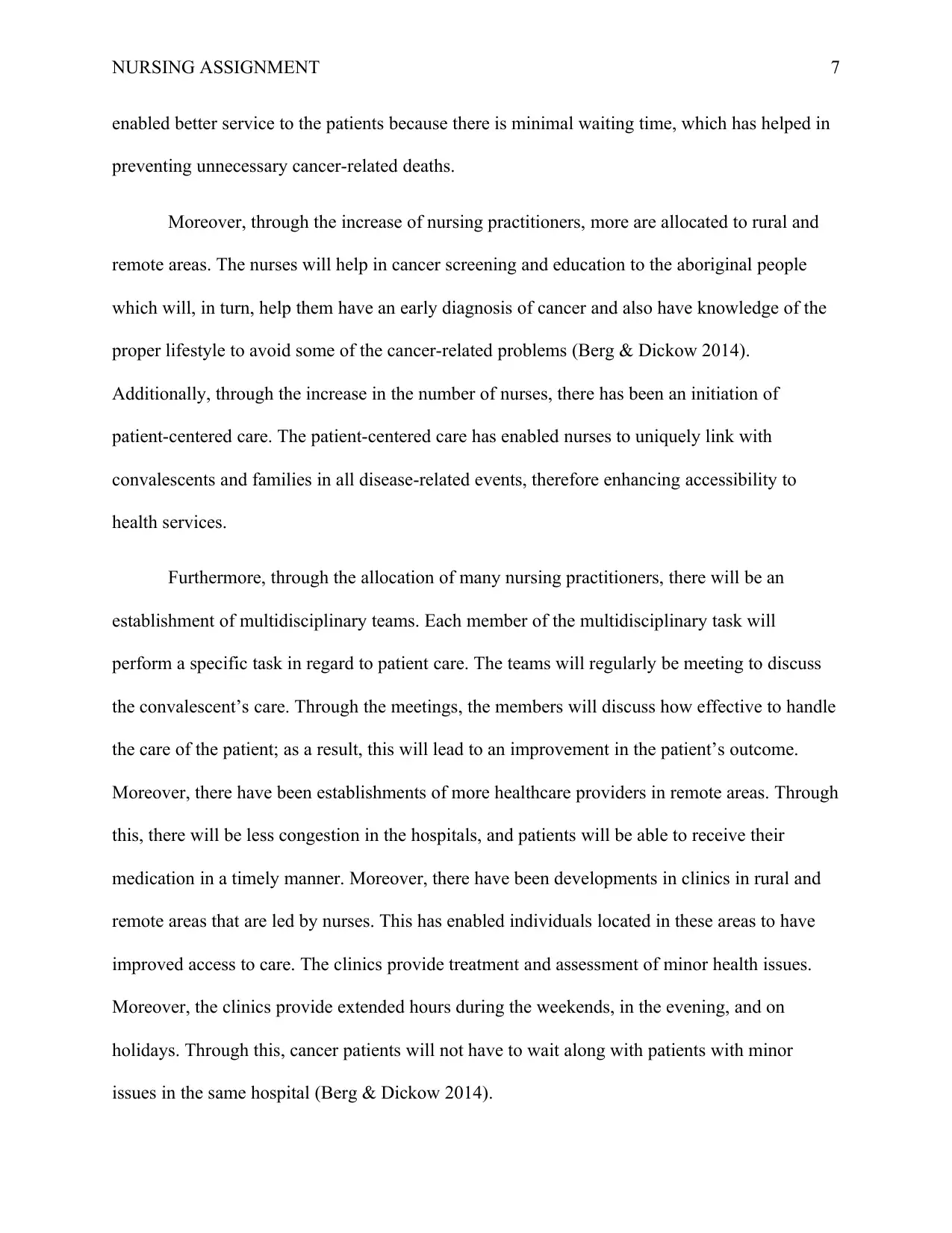
NURSING ASSIGNMENT 7
enabled better service to the patients because there is minimal waiting time, which has helped in
preventing unnecessary cancer-related deaths.
Moreover, through the increase of nursing practitioners, more are allocated to rural and
remote areas. The nurses will help in cancer screening and education to the aboriginal people
which will, in turn, help them have an early diagnosis of cancer and also have knowledge of the
proper lifestyle to avoid some of the cancer-related problems (Berg & Dickow 2014).
Additionally, through the increase in the number of nurses, there has been an initiation of
patient-centered care. The patient-centered care has enabled nurses to uniquely link with
convalescents and families in all disease-related events, therefore enhancing accessibility to
health services.
Furthermore, through the allocation of many nursing practitioners, there will be an
establishment of multidisciplinary teams. Each member of the multidisciplinary task will
perform a specific task in regard to patient care. The teams will regularly be meeting to discuss
the convalescent’s care. Through the meetings, the members will discuss how effective to handle
the care of the patient; as a result, this will lead to an improvement in the patient’s outcome.
Moreover, there have been establishments of more healthcare providers in remote areas. Through
this, there will be less congestion in the hospitals, and patients will be able to receive their
medication in a timely manner. Moreover, there have been developments in clinics in rural and
remote areas that are led by nurses. This has enabled individuals located in these areas to have
improved access to care. The clinics provide treatment and assessment of minor health issues.
Moreover, the clinics provide extended hours during the weekends, in the evening, and on
holidays. Through this, cancer patients will not have to wait along with patients with minor
issues in the same hospital (Berg & Dickow 2014).
enabled better service to the patients because there is minimal waiting time, which has helped in
preventing unnecessary cancer-related deaths.
Moreover, through the increase of nursing practitioners, more are allocated to rural and
remote areas. The nurses will help in cancer screening and education to the aboriginal people
which will, in turn, help them have an early diagnosis of cancer and also have knowledge of the
proper lifestyle to avoid some of the cancer-related problems (Berg & Dickow 2014).
Additionally, through the increase in the number of nurses, there has been an initiation of
patient-centered care. The patient-centered care has enabled nurses to uniquely link with
convalescents and families in all disease-related events, therefore enhancing accessibility to
health services.
Furthermore, through the allocation of many nursing practitioners, there will be an
establishment of multidisciplinary teams. Each member of the multidisciplinary task will
perform a specific task in regard to patient care. The teams will regularly be meeting to discuss
the convalescent’s care. Through the meetings, the members will discuss how effective to handle
the care of the patient; as a result, this will lead to an improvement in the patient’s outcome.
Moreover, there have been establishments of more healthcare providers in remote areas. Through
this, there will be less congestion in the hospitals, and patients will be able to receive their
medication in a timely manner. Moreover, there have been developments in clinics in rural and
remote areas that are led by nurses. This has enabled individuals located in these areas to have
improved access to care. The clinics provide treatment and assessment of minor health issues.
Moreover, the clinics provide extended hours during the weekends, in the evening, and on
holidays. Through this, cancer patients will not have to wait along with patients with minor
issues in the same hospital (Berg & Dickow 2014).
Paraphrase This Document
Need a fresh take? Get an instant paraphrase of this document with our AI Paraphraser
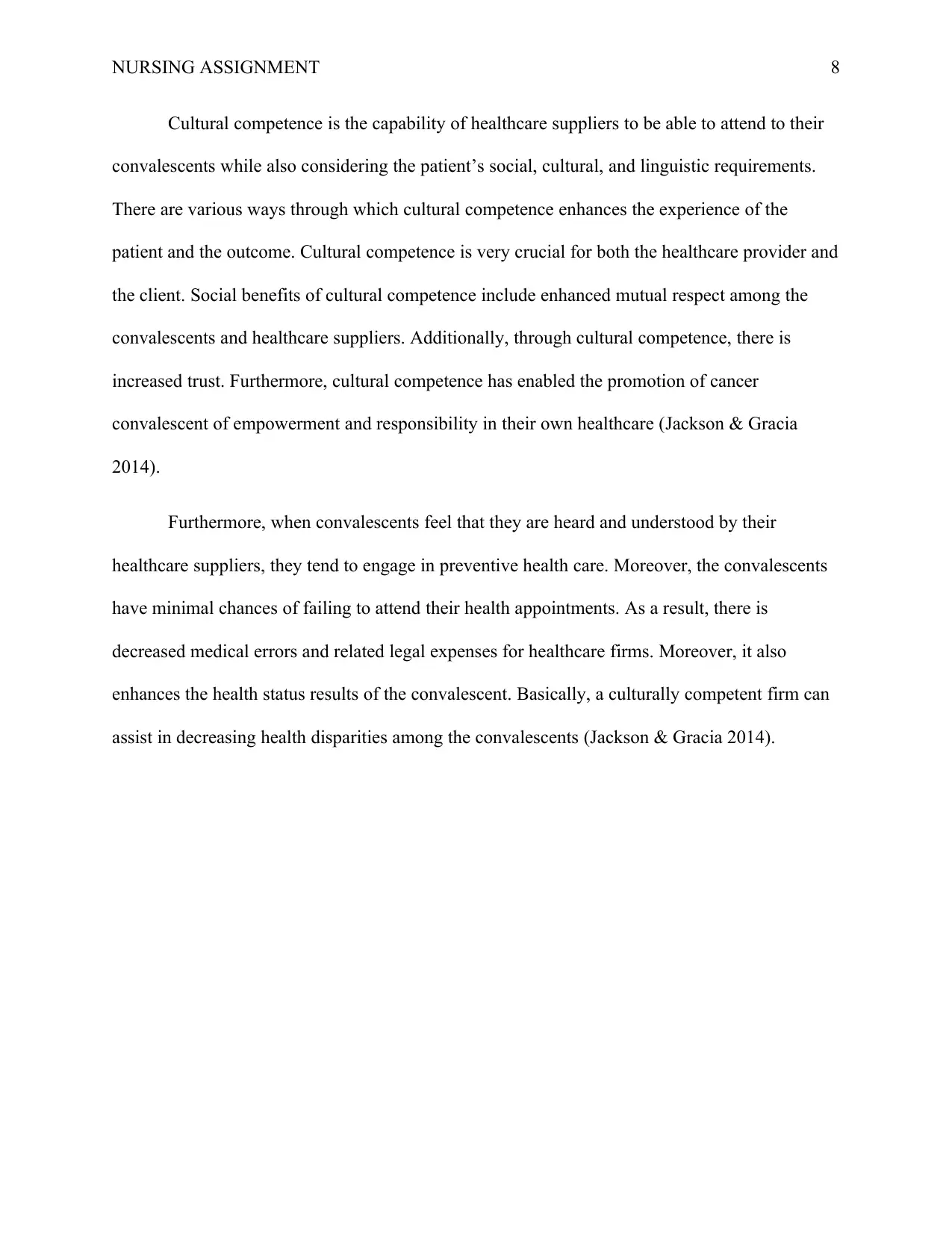
NURSING ASSIGNMENT 8
Cultural competence is the capability of healthcare suppliers to be able to attend to their
convalescents while also considering the patient’s social, cultural, and linguistic requirements.
There are various ways through which cultural competence enhances the experience of the
patient and the outcome. Cultural competence is very crucial for both the healthcare provider and
the client. Social benefits of cultural competence include enhanced mutual respect among the
convalescents and healthcare suppliers. Additionally, through cultural competence, there is
increased trust. Furthermore, cultural competence has enabled the promotion of cancer
convalescent of empowerment and responsibility in their own healthcare (Jackson & Gracia
2014).
Furthermore, when convalescents feel that they are heard and understood by their
healthcare suppliers, they tend to engage in preventive health care. Moreover, the convalescents
have minimal chances of failing to attend their health appointments. As a result, there is
decreased medical errors and related legal expenses for healthcare firms. Moreover, it also
enhances the health status results of the convalescent. Basically, a culturally competent firm can
assist in decreasing health disparities among the convalescents (Jackson & Gracia 2014).
Cultural competence is the capability of healthcare suppliers to be able to attend to their
convalescents while also considering the patient’s social, cultural, and linguistic requirements.
There are various ways through which cultural competence enhances the experience of the
patient and the outcome. Cultural competence is very crucial for both the healthcare provider and
the client. Social benefits of cultural competence include enhanced mutual respect among the
convalescents and healthcare suppliers. Additionally, through cultural competence, there is
increased trust. Furthermore, cultural competence has enabled the promotion of cancer
convalescent of empowerment and responsibility in their own healthcare (Jackson & Gracia
2014).
Furthermore, when convalescents feel that they are heard and understood by their
healthcare suppliers, they tend to engage in preventive health care. Moreover, the convalescents
have minimal chances of failing to attend their health appointments. As a result, there is
decreased medical errors and related legal expenses for healthcare firms. Moreover, it also
enhances the health status results of the convalescent. Basically, a culturally competent firm can
assist in decreasing health disparities among the convalescents (Jackson & Gracia 2014).
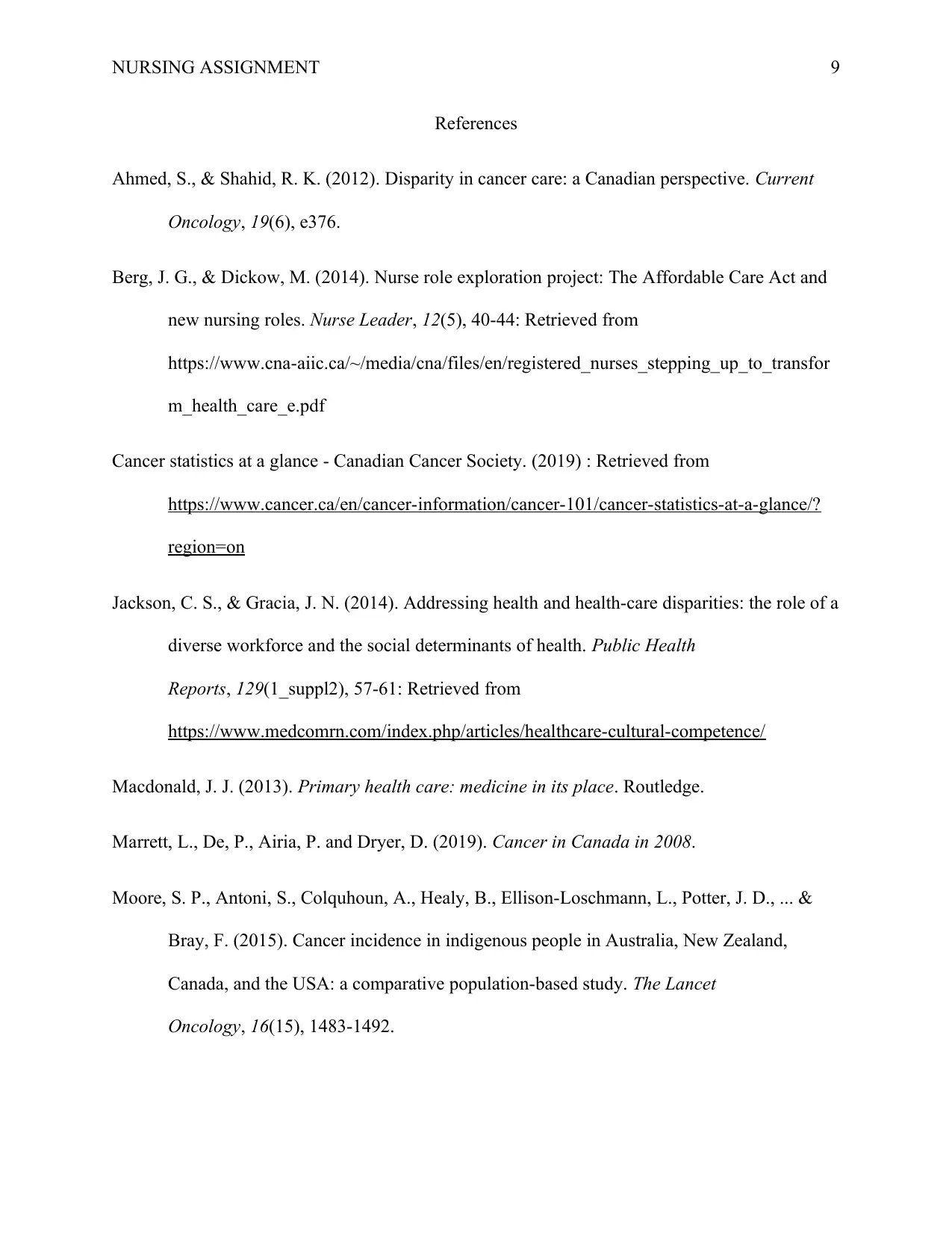
NURSING ASSIGNMENT 9
References
Ahmed, S., & Shahid, R. K. (2012). Disparity in cancer care: a Canadian perspective. Current
Oncology, 19(6), e376.
Berg, J. G., & Dickow, M. (2014). Nurse role exploration project: The Affordable Care Act and
new nursing roles. Nurse Leader, 12(5), 40-44: Retrieved from
https://www.cna-aiic.ca/~/media/cna/files/en/registered_nurses_stepping_up_to_transfor
m_health_care_e.pdf
Cancer statistics at a glance - Canadian Cancer Society. (2019) : Retrieved from
https://www.cancer.ca/en/cancer-information/cancer-101/cancer-statistics-at-a-glance/?
region=on
Jackson, C. S., & Gracia, J. N. (2014). Addressing health and health-care disparities: the role of a
diverse workforce and the social determinants of health. Public Health
Reports, 129(1_suppl2), 57-61: Retrieved from
https://www.medcomrn.com/index.php/articles/healthcare-cultural-competence/
Macdonald, J. J. (2013). Primary health care: medicine in its place. Routledge.
Marrett, L., De, P., Airia, P. and Dryer, D. (2019). Cancer in Canada in 2008.
Moore, S. P., Antoni, S., Colquhoun, A., Healy, B., Ellison-Loschmann, L., Potter, J. D., ... &
Bray, F. (2015). Cancer incidence in indigenous people in Australia, New Zealand,
Canada, and the USA: a comparative population-based study. The Lancet
Oncology, 16(15), 1483-1492.
References
Ahmed, S., & Shahid, R. K. (2012). Disparity in cancer care: a Canadian perspective. Current
Oncology, 19(6), e376.
Berg, J. G., & Dickow, M. (2014). Nurse role exploration project: The Affordable Care Act and
new nursing roles. Nurse Leader, 12(5), 40-44: Retrieved from
https://www.cna-aiic.ca/~/media/cna/files/en/registered_nurses_stepping_up_to_transfor
m_health_care_e.pdf
Cancer statistics at a glance - Canadian Cancer Society. (2019) : Retrieved from
https://www.cancer.ca/en/cancer-information/cancer-101/cancer-statistics-at-a-glance/?
region=on
Jackson, C. S., & Gracia, J. N. (2014). Addressing health and health-care disparities: the role of a
diverse workforce and the social determinants of health. Public Health
Reports, 129(1_suppl2), 57-61: Retrieved from
https://www.medcomrn.com/index.php/articles/healthcare-cultural-competence/
Macdonald, J. J. (2013). Primary health care: medicine in its place. Routledge.
Marrett, L., De, P., Airia, P. and Dryer, D. (2019). Cancer in Canada in 2008.
Moore, S. P., Antoni, S., Colquhoun, A., Healy, B., Ellison-Loschmann, L., Potter, J. D., ... &
Bray, F. (2015). Cancer incidence in indigenous people in Australia, New Zealand,
Canada, and the USA: a comparative population-based study. The Lancet
Oncology, 16(15), 1483-1492.
⊘ This is a preview!⊘
Do you want full access?
Subscribe today to unlock all pages.

Trusted by 1+ million students worldwide

NURSING ASSIGNMENT 10
Topic: Cancer in Canada. (2019): Retrieved from https://www.statista.com/topics/4334/cancer-
in-canada/
Topic: Cancer in Canada. (2019): Retrieved from https://www.statista.com/topics/4334/cancer-
in-canada/
1 out of 10
Related Documents
Your All-in-One AI-Powered Toolkit for Academic Success.
+13062052269
info@desklib.com
Available 24*7 on WhatsApp / Email
![[object Object]](/_next/static/media/star-bottom.7253800d.svg)
Unlock your academic potential
Copyright © 2020–2025 A2Z Services. All Rights Reserved. Developed and managed by ZUCOL.





